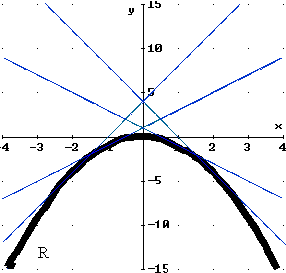Recall that if a line is rising left to right, it has a
positive slope.
If
a line is falling left to right, it has negative slope.
|
Recall that if a line is rising left to right, it has a
positive slope. |
| |
| If
a line is falling left to right, it has negative slope. |
| |
Horizontal lines have zero slope and vertical lines have no slope.
Also remember that the first derivative tells
us the slope of the tangent line at a point.
| If the
graph of a function is rising from left to right, we say the function is increasing. If
you draw tangent lines at various points on the graph of an increasing function,
all the lines will have positive slopes. This tells us that if a function
is increasing, its first derivative will be positive. |

|
| If
the graph of a function is falling from left to right, we say the function is
decreasing. If you draw tangent lines at various points on the graph of
a decreasing function, all the lines will have negative slopes. This tells
us that if a function is decreasing, its first derivative will be negative. |

|
| A
graph with curvature such as the one at right is called concave up. A concave
up graph holds water. It is cup-shaped. The
spelling of cup should help you remember concave up. |

| |
| A
graph with curvature such as the one at right is called concave down. A concave
down graph spills water. It is cap shaped. |

| |
| Letís
see how we can use calculus to tell if a function is concave up. Look at
the picture at right. Some of the tangent lines have positive slopes and
some of the tangent lines have negative slopes. However, if we look from
left to right, we see that the slopes start out negative, then get bigger and
bigger, eventually becoming positive. Since the slopes of the tangent lines
are increasing, that means the first derivative is increasing. If |

| |
| Now
we will see how to use calculus to tell if a function is concave down. Look
at the picture at right. Some of the tangent lines have positive slopes
and some of the tangent lines have negative slopes. However, if we look
from left to right, we see that the slopes start out positive, then get smaller
and smaller, eventually becoming negative. Since the slopes of the tangent
lines are decreasing, that means the first derivative is decreasing. If
|

| |
An inflection point is a point where the graph changes concavity.
But
just because a the second derivative changes sign does not necessarily mean you
have an inflection point.
For example, the graph of the reciprocal function,
y = 1/x, is concave down to the left of zero and concave up to the right of zero.
Yet zero is not an inflection point. It is an asymptote. To be
an inflection point, an x-value must produce a corresponding y-value.
A graph
can change concavity at an inflection point or a discontinuity.